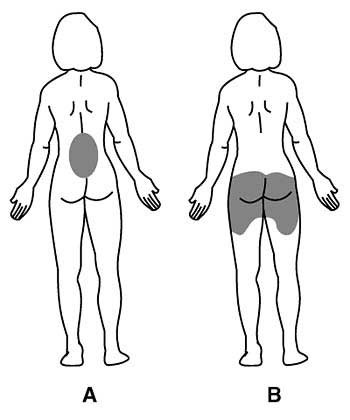Massage Therapy for Low Back Pain in Pregnancy
Pregnancy is a time when your body undergoes many changes in a short amount of time, and this takes of a toll on your musculoskeletal system. The changes in posture and alignment, along with increased ligament laxity and the extra weight your body has to carry often result in nagging and sometimes debilitating aches and pains.
Lower back pain is a very common issue that crops up in the later months of pregnancy. In order to effectively address pregnancy-related back pain through massage therapy, it is helpful to differentiate between posterior pelvic pain and low back pain, as each condition requires a different treatment approach.
The picture below illustrates the difference in the pain patterns of low back pain (A) vs posterior pelvic pain (B).
Our Pre- and Post-Natal Massage Therapists
To book a low back pain massage therapy appointment
with one of our Vancouver RMT’s,
click here (online booking system) or call us at 604-633-9593
MZ1- 970 Burrard St.
(mezzanine – Electra Building)
Downtown Vancouver
Massage Therapy appointments available:
7 days a week 8 am to 8 pm
Pain Posterior Pelvic Pain
Posterior pelvic pain, (also known as pelvic girdle pain or sacroiliac joint dysfunction) is four times more common than low back pain, with pain being felt lower than lumbar pain. Although it can occur at any time during the pregnancy, this pain starts on average around the 18th week and affects about 20% of pregnant women. Posterior pelvic pain can occur on its own, or concurrently with low back pain (about 8% of pregnant women experience both). Deep, boring pain and/or a catching sensation is often felt beside one or both of the sacroiliac joints, with referral into the gluteal muscles, the groin and into the sides or back of the thighs. This pain is often made worse by activity, extreme ranges of motion, changing position in bed, standing on one leg, stair climbing and excessive sitting, and tends to be more severe towards the end of the day. Posterior pelvic pain is sometimes confused with sciatica, however, true sciatica is uncommon in pregnancy (only about 1 in 10,000 women suffer from true sciatic pain in pregnancy). Unlike sciatica, posterior pelvic pain does not present with changes in sensation or a feeling of pins and needles, which indicate nerve involvement.
Although it is not yet clear why this pain occurs, it is considered to be caused by the shift in the position of the sacroiliac joints causing sacroiliac joint dysfunction, along with the widening of the pubic symphysis and stretching of the pelvic ligaments caused by changes in the levels of relaxin, estrogen and progesterone. Secondary muscle tightness results as the body increases muscle tension in order to stabilize the area.
Posterior pelvic pain cannot be prevented since it is caused by hormonal changes. However, secondary muscle tension can be addressed. Massage therapy can address secondary pain and muscle tightness by focusing on releasing tension in the gluteals, hip rotators and abductors, as well as in the lumbar area and other compensatory musculature. An RMT can also provide exercises in order to strengthen the neuromuscular control of the pelvic stabilizers in an attempt to reduce pain and dysfunction. A supportive pelvic belt can also offer some relief as it helps redistribute the extra weight.
Posterior pelvic pain usually subsides within 3 months of delivery, however, in some cases, it can become chronic and might necessitate rehabilitation.
Low Back Pain
Low back pain is felt in the lumbar spine and will most likely resemble the type of back pain you might have occasionally felt before pregnancy. The pain will be felt in the lumbar spine, often at waist level.
Low back pain is caused by increases in ligament laxity resulting in compensatory muscle tension, changes in posture, increased weight and changes in muscle balance.
The growing uterus pulls the pelvis forward, shifting your center of gravity, increasing lumbar lordosis (the curve of your lower back). The arch of the low back increases, putting more pressure on the facet joints of the lumbar spine and shortens and tightens the lumbar area. Due to the increase in the size of the abdomen the abdominal muscles become stretched outwards from the midline, resulting in changes in muscle balance and the tightening of the compensatory musculature.
Massage therapy can help address low back pain by releasing muscle tension in the lumbar area and providing postural education and exercises that help reduce low back pain.
RMTs are trained to provide safe assessment and treatment of pregnancy aches and pains and regular massage as part of your care can help you relieve physical discomfort, reduce stress levels and support you on your prenatal journey.
Your Wellness, Our Commitment

Over 25 Certified RMTs
Available every day from 8 am to 8 pm.

Unparalleled Expertise
Our therapists average over 7 years of hands-on experience.

Comprehensive Treatments
From sports injuries to prenatal care, we’ve got you covered.

Weekend Appointments
Because your convenience is our priority.

Part of Electra Health
Dive into a multidisciplinary health experience in the heart of Vancouver.
Hear From Our Satisfied Clients
To book a deep tissue massage therapy appointment
with one of our Vancouver RMT’s,
click here (online booking system) or call us at 604-633-9593
Deep Tissue Massage Therapy – Vancouver
MZ1- 970 Burrard St.
(mezzanine – Electra Building)
Downtown Vancouver
Massage Therapy appointments available:
7 days a week 8 am to 8 pm










